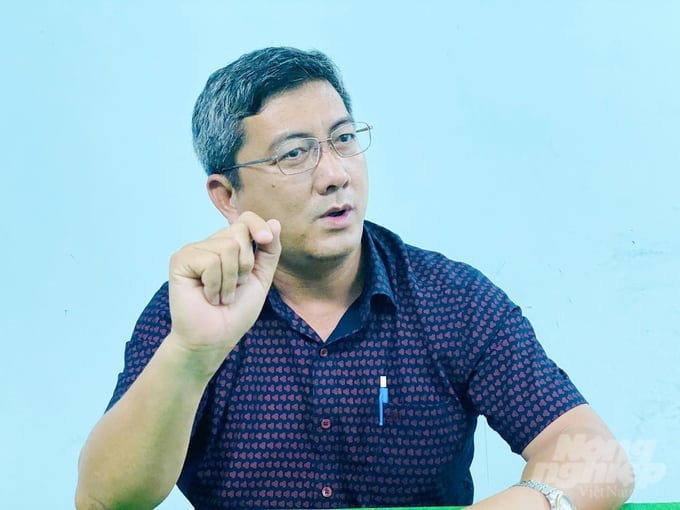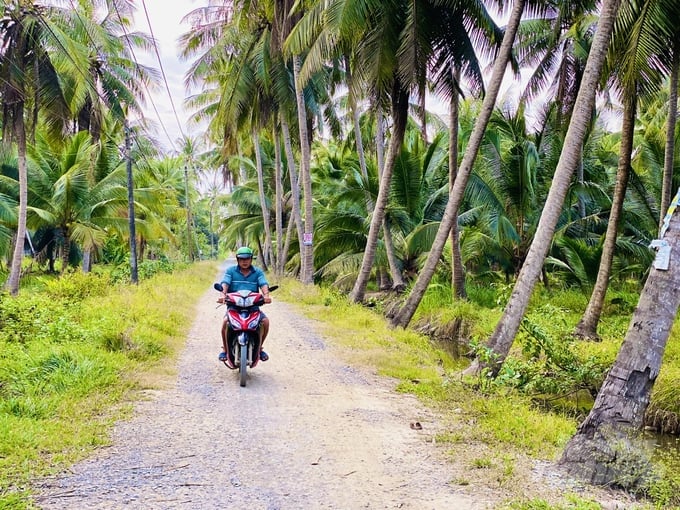May 29, 2025 | 22:15 GMT +7
May 29, 2025 | 22:15 GMT +7
Hotline: 0913.378.918
May 29, 2025 | 22:15 GMT +7
Hotline: 0913.378.918

Dr. Tran Minh Hai, Vice Principal of the Institute for Public Policy and Rural Development under the Ministry of Agriculture and Rural Development. Photo: Le Hoang Vu.
The Vietnam Agriculture Newspaper recently interviewed Dr. Tran Minh Hai, Vice Principal of the Institute for Public Policy and Rural Development under the Ministry of Agriculture and Rural Development, regarding the acquisition of carbon credits from rice and coconut farming.
According to Mr. Hai, the 1997 Kyoto Protocol required countries which emit a significant amount of carbon dioxide to pay a fine. Conversely, countries which absorb a substantial amount of carbon dioxide were entitled to payments to foster a clean atmosphere. Consequently, this protocol formed the basis of the carbon market.
The general public believes that Vietnam's sale of 10.3 million forest carbon credits at 5 USD per credit is too low, as there are parties willing to pay higher prices. What is your comment on this issue?
There is no basis to consider 5 USD per carbon credit as low because the price of each carbon credit is determined by the market, and the method of carbon credit formation. Because the carbon market consists of both voluntary and mandatory markets, the price of carbon credits differs between these markets.
The voluntary market involves businesses and producers voluntarily reducing greenhouse gas emissions and purchasing carbon credits, including projects for reducing carbon emission from rice and coconut farming, or from afforestation.
Our current methods for rice and coconut farming have been relatively standardized. However, farmers must change their practices or invest in modern greenhouse gas emission reduction technology to start earning carbon credits.
Subsequently, the resulting reduction in greenhouse gas emissions is measured and certified as the number of tons of carbon reduced (1 ton of carbon equals 1 carbon credit), which constitutes the earned carbon credits. On the other hand, forestr carbon credits are calculated based on the amount of carbon absorbed by the forest.
The mandatory carbon market requires stakeholders to reduce greenhouse gas emissions, as reflected in emission quotas imposed by regulatory authorities on individual stakeholder. These facilities are permitted to trade, buy, and exchange these emission quotas on the market. Notably, businesses that produce greenhouse gas emissions (converted into CO2 equivalents) must purchase carbon credits to compensate for the emissions generated by their production activities or other harmful gases emitted into the environment.

Farmers must change their practices or invest in modern greenhouse gas emission reduction technology to start earning carbon credits. Photo: Le Hoang Vu.
Vietnam recently sold forest carbon credits to intermediary partners in the voluntary market, who purchased large quantities based on project commitments. Consequently, this sale determines the average price for forest carbon credit. Subsequently, businesses in the mandatory market must contact these intermediaries to repurchase carbon credits. The intermediaries sell carbon credits at a fixed price, and businesses must comply to avoid penalties and greater losses.
But why are Vietnam's forest carbon credits sold at 5 USD per credit whereas carbon credits from other countries may fetch a price of up to 100 USD per credit?
Within the voluntary carbon market, project proposals must demonstrate implementation methods, total investment capital, measurement techniques, and investment sectors. All information must be recorded in a "carbon emission reduction log." Subsequently, independent assessment units will issue carbon credits on these project data.
The price of a carbon credit typically depends on investment capital and investment sector. On the other hand, some businesses offer exceptionally high prices for carbon credits in sectors where emission reduction is encouraged, such as plastics, fertilizers, and steel production. Furthermore, sellers must demonstrate the investment capital required to generate one carbon credit in negotiations. The selling price of carbon credits will correspondingly rise with a large investment capital, thereby encouring challenging industries to produce carbon credits.

The Vietnamese Government recently sold forest carbon credits to intermediary partners (WB) in the voluntary market, who purchased large quantities based on project commitments. Photo: Le Hoang Vu.
The investment capital for coconut farming is relatively low. Similarly, forest carbon credit incur minimal investment costs. As a result, forest carbon credits typically range from 5 to 10 USD per credit. Forest carbon credits are sold at similar prices worldwide. Notably, forest carbon credits from the Amazon are sold for 1.5 USD per credit.
What do farmers need to do to earn a carbon credit from coconut or rice farming?
In order to obtain carbon credits from coconut or rice farming, farmers must first propose a project to the competent authorities for approval and registration with purchasing and assessment units. For example, with approximately 76,000 hectares of coconut farming area in Ben Tre province, farmers or hired third parties looking to participate in the carbon market must measure the initial levels of natural carbon sequestration and natural greenhouse gas emission from coconut farming activities such as fertilization, pesticide spraying, coconut husking, and its by-products.
Subsequently, measures must be implemented to reduce carbon emissions into the environment by reducing the usage of chemical fertilizers and pesticides, coconut leaf and husk processing, among others. During project implementation, stakeholders must keep a carbon reduction practice log, and carbon emission measuring devices installed in coconut farms will measure environmental parameters to determine the amount of emitted carbon.
The number of credits obtained will be the difference in emitted carbon after project implementation compared to the initial levels per hectare of coconut/rice per year. For example, if each hectare of coconut farming area reduces 5 tons of carbon emissions per year after the project is concluded, 5 carbon credits will be generated per hectare. This process will be handled by units responsible for measuring carbon emissions into the environment, with a company assessing and issuing carbon credits for the project.
A similar principle is applicable to the Project for one million hectares of high-quality rice in the Mekong Delta by 2030, supported by a non-refundable loan of 40 million USD and an ODA loan of 400 million USD from the World Bank. Businesses, cooperatives, and farmers are motivated to participate in the emission reduction rice farming project to earn additional income from selling carbon credits. Consequently, they must fully understand and participate in various procedures, including: reducing inputs such as seeds, agricultural materials; the conversion from chemical inputs to microbial and organic inputs requires alternate wetting and drying irrigation, and removal of straw from paddy fields.
Notably, alternate wetting and drying irrigation and the removal of straw from paddy fields can potentially generate more carbon credits compared to other procedures. Additionally, improvements in production processes and the installation of emission reduction measurement, reporting, and verification systems (MRV) must be implemented. Additionally, farmers are instructed to reduce the rice seeding rate from 120 to 150 kilograms per hectare to 80 kilograms per hectare, manage the on-field water levels using a water level measuring system, and pump water only when the water level reaches negative 15 to 19 centimers. As a result, they can expect a reduction of 2 to 3 water pumping cycles per crop.

In the Project for "one million hectares of high-quality rice in association with emission reduction and green growth in the Mekong Delta region", alternate wetting and drying irrigation and the removal of straw from paddy fields can potentially generate more carbon credits compared to other procedures. Photo: Le Hoang Vu.
This measure helps reduce methane (CH4) emissions during the rice farming process by allowing the rice fields to dry and crack. Other methods of reducing emissions include replacing the burning of straw in the fields by utilizing them for mushroom cultivation, composting, and employing microbial decomposition methods, etc. Subsequently, businesses and farmers may request a certification agency to assess and certify the emission reduction process and the quantity of greenhouse gas emissions reduced, and subsequently receive carbon credit certificates. Businesses and farmers can then sell the acquired carbon credits and earn income.
Some people believe that rice farmers may only need to engage in minimal agricultural practices to earn revenue from carbon credits in the future. Do you think this is true?
Absolutely not. As I mentioned earlier, an approved project is needed, and the commitments within the project must be diligently carried out by farmers. Accurate records of emission reductions must be maintained. If farmers fail to understand and implement these steps correctly, the amount of carbon emission reduction may not meet the initial commitments, thereby resulting in reduced carbon credits and low economic efficiency. Failure to comply may even lead to financial losses from consulting costs, and adverse impacts on other projects in Vietnam.
The Project for "one million hectares of high-quality rice in association with emission reduction and green growth in the Mekong Delta region" is also an investment project. Without an effective implementation plan, it will also incur losses. As a result, the project site must be extensive and easily managed to keep investment costs low and the quantity of carbon credits high. Priority will be given to significant emission reduction measures such as alternate wetting and drying irrigation, straw collection after rice harvest, and reducing the amount of rice seed sown. This project extends beyond poverty alleviation or the construction of new rural areas in a specific district; it is a long-term economic strategic project.
Rice and coconut farmers in the Mekong Delta region must adjust their farming practices to obtain carbon credits for profit. This effort includes implementing alternate wetting and drying (AWD) irrigation in place of continuous flooding, cluster seeding in place of broadcast seeding, and collecting straw after harvest to reduce emissions of harmful gases into the environment.
Translated by Nguyen Hai Long
/2025/05/25/4127-3-073637_820.jpg)
(VAN) Thanks to the promotion from an FAO-implemented project, vegetable production in greenhouses in Moc Chau has seen strong development, from 1.5 hectares in 2021 to nearly 50 hectares in 2024.

(VAN) FAO has recently supported USD 140,000 to implement the project 'Risk mitigation human-animal interface risks through disease control initiatives in pig farming.'

(VAN) The People's Committee of Tra Vinh province has approved an adjustment to the investment policy for the Green Hydrogen Plant project, increasing its area to approximately 52.76 hectares.
![Reducing emissions from rice fields: [2] Farmers’ commitment to the soil](https://t.ex-cdn.com/nongnghiepmoitruong.vn/608w/files/news/2025/05/05/dsc08881jpg-nongnghiep-140632.jpg)
(VAN) Clean rice cultivation model in Thuong Tan commune, Bac Tan Uyen district, is assisting local residents in achieving sustainable agriculture by substantially reducing costs, increasing productivity, and protecting the environment.

(VAN) At the conference to disseminate Resolution No. 68, AgriS introduced its digital agricultural ecosystem and reaffirmed its commitment to accompanying the Government in promoting private sector development and sustainable agriculture.

(VAN) 'Blue Ocean - Blue Foods' initiative is designed to restore marine ecosystems and establish sustainable livelihoods for local communities by cultivating a minimum of 1,000 hectares of cottonii seaweed in the first three years.
/2025/05/21/4642-3-112707_603.jpg)
(VAN) The V-SCOPE project has made direct contributions to three out of six pillars of the Comprehensive Strategic Partnership between Vietnam and Australia.